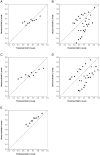Predicting glycated hemoglobin levels in the non-diabetic general population: Development and validation of the DIRECT-DETECT prediction model - a DIRECT study
- PMID: 28187151
- PMCID: PMC5302787
- DOI: 10.1371/journal.pone.0171816
Predicting glycated hemoglobin levels in the non-diabetic general population: Development and validation of the DIRECT-DETECT prediction model - a DIRECT study
Abstract
Aims/hypothesis: To develop a prediction model that can predict HbA1c levels after six years in the non-diabetic general population, including previously used readily available predictors.
Methods: Data from 5,762 initially non-diabetic subjects from three population-based cohorts (Hoorn Study, Inter99, KORA S4/F4) were combined to predict HbA1c levels at six year follow-up. Using backward selection, age, BMI, waist circumference, use of anti-hypertensive medication, current smoking and parental history of diabetes remained in sex-specific linear regression models. To minimize overfitting of coefficients, we performed internal validation using bootstrapping techniques. Explained variance, discrimination and calibration were assessed using R2, classification tables (comparing highest/lowest 50% HbA1c levels) and calibration graphs. The model was externally validated in 2,765 non-diabetic subjects of the population-based cohort METSIM.
Results: At baseline, mean HbA1c level was 5.6% (38 mmol/mol). After a mean follow-up of six years, mean HbA1c level was 5.7% (39 mmol/mol). Calibration graphs showed that predicted HbA1c levels were somewhat underestimated in the Inter99 cohort and overestimated in the Hoorn and KORA cohorts, indicating that the model's intercept should be adjusted for each cohort to improve predictions. Sensitivity and specificity (95% CI) were 55.7% (53.9, 57.5) and 56.9% (55.1, 58.7) respectively, for women, and 54.6% (52.7, 56.5) and 54.3% (52.4, 56.2) for men. External validation showed similar performance in the METSIM cohort.
Conclusions/interpretation: In the non-diabetic population, our DIRECT-DETECT prediction model, including readily available predictors, has a relatively low explained variance and moderate discriminative performance, but can help to distinguish between future highest and lowest HbA1c levels. Absolute HbA1c values are cohort-dependent.
Conflict of interest statement
The Novo Nordisk funding did not influence the scientific work, or have any influence on design, data collection, analyses or interpretation of the results. We can confirm that this does not alter our adherence to PLOS ONE policies on sharing data and materials.
Figures

References
-
- Gillies CL, Abrams KR, Lambert PC, Cooper NJ, Sutton AJ, Hsu RT, et al. Pharmacological and lifestyle interventions to prevent or delay type 2 diabetes in people with impaired glucose tolerance: systematic review and meta-analysis. BMJ 2007. February 8;334(7588):299 10.1136/bmj.39063.689375.55 - DOI - PMC - PubMed
-
- Koivula R, Heggie A, Barnett A, Cederberg H, Hansen T, Koopman A, et al. Discovery of biomarkers for glycaemic deterioration before and after the onset of type 2 diabetes: rationale and design of the epidemiological studies within the IMI DIRECT Consortium. Diabetologia 2014;57(6):1132–42. 10.1007/s00125-014-3216-x - DOI - PMC - PubMed
Publication types
MeSH terms
Substances
LinkOut - more resources
Full Text Sources
Other Literature Sources
Medical

